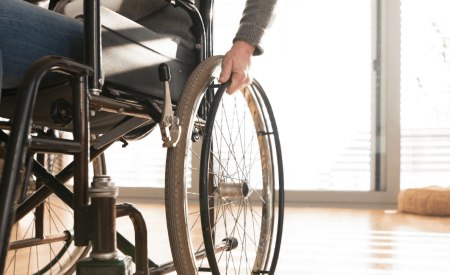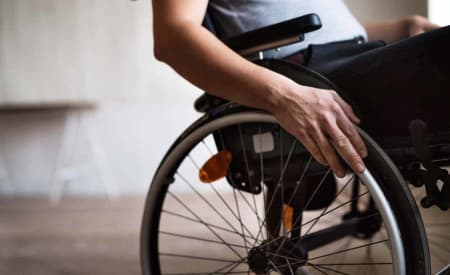I was sent the below link and information from Christy Clawson from wondermoms.org sent to me on Sat 12/06/2021
https://www.apartmentguide.com/blog/disability-apartments-looks-features/
Bekah Steenbock
Updated: August 27, 2019
3 Minute Read
There’s a misconception that handicap accessibility for apartments is related to ADA compliance. It’s an easy mistake to make; the ADA applies to public buildings, common areas in apartment buildings, and most units in newer apartment complexes. If you’re looking at older buildings, the ADA doesn’t necessarily apply (Learn more here).
That doesn’t mean you’re out of luck. Many apartment homes provide basic accessibility features and have one or two handicap-accessible units in their building. But what do those apartments look like? Here’s what you can expect to see in a disability apartment, and how it will help you (or the person you’re helping) in daily life.
Entryways and Hallways
Entryways and hallways will be wider to accommodate a wheelchair, both because of its width, and to allow someone in a wheelchair to turn around comfortable.
Flooring
Flooring in these units is typically vinyl or a thin flat carpet, which is less of an obstacle to get over in a wheelchair.
Sinks
In a fully- accessible unit, there will be a space for a wheelchair under the sink and the plumbing will have been arranged to accommodate this.
Cabinets
Cabinets in units which are fully handicap – accessible will be lower than those in a regular unit. There are also likely to be fewer cabinets at floor level to make room for rolling the wheelchair right up to the counter tops.
Counter tops
Counter tops will also be lower, to make the work space accessible from a wheelchair. Usually, they will be 30 inches off the ground, rather than 36. As mentioned above, floor-level cabinets will often be removed from under the sink and counter tops to make space for the wheelchair.
Appliances
Handicap-accessible appliances, such as the stove, will have all the knobs on the front instead of along the back panel, making them easier and safer to reach.
Bathrooms
Bathrooms will have grab bars and roll-in showers (along with reinforced walls to support the grab bars). Some are equipped with a bench, but mobile ones can be easily purchased if there isn’t one. Toilets are higher and will also have grab bars.
The sink should have a faucet that’s operated with a single lever, rather than multiple knobs.
Light Switches
Light switches are lower to be accessible from a wheelchair. Power outlets will also be adjusted at different levels, sometimes higher, sometimes lower.
Doorways and Access
The door to the apartment should be wide enough to fit a wheelchair, with a ramp leading up to it if it’s elevated. The threshold should be flush with the floor, to keep getting through the door from being a bumpy experience.
Parking
Handicap -designated parking spaces are set aside and marked for use by residents with handicaps or wheelchairs. In most cases, they will be adjacent to the unit, or very near, with a clear flat pathway from the door to the parking space. Some may allow unloading from a van: inquire with the management if you need this type of parking.
Personal alarm system
This is usually something you bring but could be set up already in the apartment for you. This allows easy contact with emergency services in case you’ve fallen or had a similar emergency.
Common Areas
Common areas of newer apartment complexes with handicap accessible units are designed to accommodate renters in wheelchairs. Common area hallways are very wide, and light switches are lower. You can find ramp access to sidewalks, and elevators where needed to reach common areas.
***
Disability Apartments FAQs
Can I be charged more for a handicap – accessible home?
These apartments should be the same cost per month as a similar non- accessible apartment. The landlord can’t force unfair terms on you, such as charging more for a unit comparable to other, non-handicap accessible units, as part of the Fair Housing Act. You may also be able to get assistance through Department of Housing and Urban Development programs, so check there and you may be able to find a better deal.
No handicap – accessible apartments are available; what options do I have?
Most likely, your best option is to make the modifications yourself. If you have a doctor’s note of your disability, you can fill out paperwork to make “reasonable accommodations” to the apartment. Unlike more superficial upgrades, the landlord can't deny reasonable changes, but just like those upgrades, you’re most likely responsible for the costs of modifying the unit and then returning it to its original state. You may be able to convince the landlord to pay some of the costs, or not require the modifications to be undone (their building might be more attractive to tenants with at least one, dedicated handicap-accessible unit), but expect to pay all the costs yourself.
***
Hunting for an apartment home while confined to a wheelchair is challenging. Make sure you ask the landlord if they have accessible units available for rent before you go to the trouble to visit. Tour the complex to ensure that it’s easy for you to get around and has the features you need to be comfortable.
Being in a wheelchair doesn’t have to hold you back, from having an excellent quality of life, and finding an apartment built to accommodate you can make all the difference.
Read more: The Best Ranked Cities for People with Disabilities



